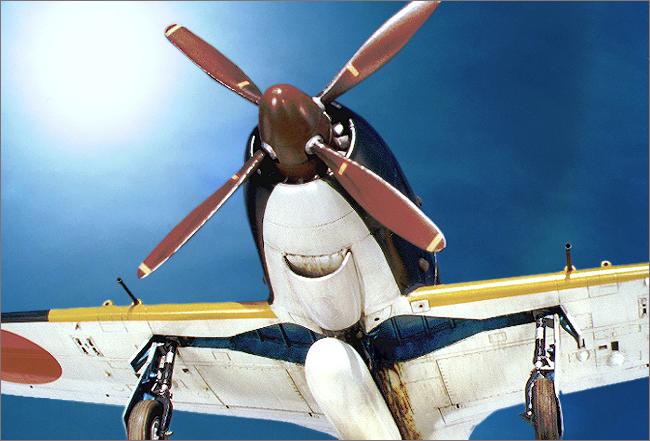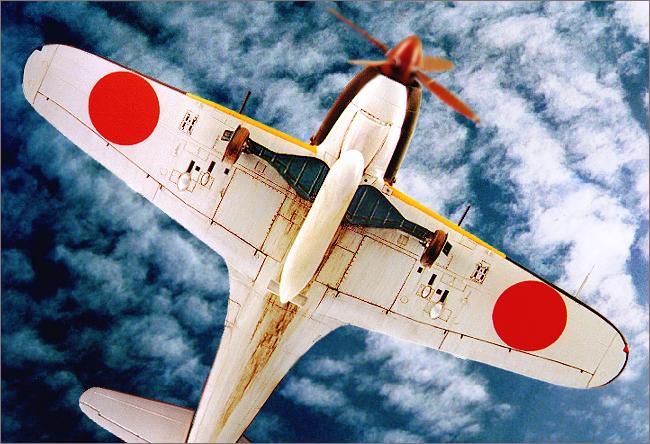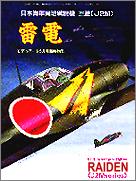|
Tamiya's 1/48 Raiden ( Jack ) |
Mitsubishi
J2M3 Interceptor Raiden (Jack)
Model, Photos & Text by Chris Beaumont
|
Tamiya's 1/48 Raiden ( Jack ) |
Six more images in the text and six more at the bottom of the page.
I n t r o d u c t i o n |
This model is finished in probably the most distinctive and well known paint scheme of the Raiden seen in reference photos and illustrations.
It was the IJN aircraft flown by Lt.Yoshihiro Aoki of the 352 Flying Group, based at Kanoya Air Base during 1945. He had two dynamic lightning bolts emblazoned on each side of the fuselage.You can observe in one of the click-on thumbnails below how they were not symmetrically applied markings. They differed in shape and position on either side.
The Japanese codename for the J2M3 was "Raiden" which is said to translate as Thunderbolt ; this is where the nose art symbolism displays the connection it is presumed. The "J" in J2M3 is the Japanese designation for this aircraft being a Land Based Interceptor .
J a c k f r o m t h e B o x |
The kit was assembled strictly out of box. Any extra detail had to be represented by paintwork. The overall paint treatment was mainly attributed to photographs in the "Famous Airplanes of the World, Navy Interceptor Raiden" photo manual. They were virtually all I needed to really bring Tamiya's Raiden to life. There are a total of 5 pictures of Yoshihiro's aircraft printed in the book. The detailed poses of his plane were good enough to accurately copy the striking paint chipping of the upper wing root panelling to bothsides of the model. The boots of pilot and ground crew caused this burnished effect by their constant footwork on these areas.
There is a useful reference picture, presumably of the pilot, sprucing up the lightning
bolts with fresh paint. I simulated them completely repainted on this model ,
meaning I didn't have to chip the decals at all and only dirtied them a little.
|
| This
front-on pose is a near recreation from a photograph of a Raiden standing on the concrete
apron. The photo appears on page 157 of Model Art's Raiden reference book. |
There were such a surprising number of WWII era photographs of a Japanese aircraft exhibiting very glossy paintwork and glistening strongly in the sun in the Raiden FAOTW reference that it seemed appropriate to apply the same finish to this model. The paint work was polished to achieve a realistic flat and glossy panelled effect.
U n d e r s u r f a c e s |

Factory part identification plates, observed in reference photo's and seen here on the black landing gear struts, were fashioned from unused kit decals. Tamiya directed that all inside surfaces, being the inner side of the landing gearstrut covers and, the wheel wells were to be painted in "clear greenish blue paint" over the base coat of the aluminium color. This directive applied to the cockpit interior as well except for the joystick and seat. Depending on what information you agree with these days the cockpit interior color seems to be a toss-up between using the latter directive or a straight pale green color.

Full photographic views of the Raiden's undersurfaces could not be found so weathering of these areas was devised from studying pictures of under-shots of similar types of wartime and contemporary aircraft.
R e f e r e n c e s |
|
 |
| Famous
Airplanes of the World No.61 Navy Interceptor "Raiden" |
Model Art No. 470 IJN Interceptor Fighter Raiden |
These top quality references are available from specialist hobby shops and HobbyLink Japan
Click on the thumbnailed images below to view full-size. Click the back arrow on your
browser to retrun to this page.
More Raiden research can be found at
Dan Salamone's HyperScale Feature
...and you can see more Japanese aircraft at
Hiroyuki
Takeuchi's " Wings Of The Sun " Japanese Aircraft Page
Model, Article Text and Photographs Copyright © 1998 by Chris Beaumont
Page Created 27 October, 1998
Last Updated 26 July, 2007
Back to HyperScale Main Page
Back to Feature Articles